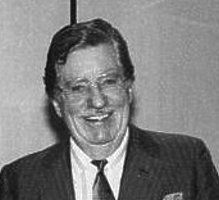
KEN MACKINTOSH
A Living Legend
At the Empire
In the late 1940's 50's 60's and 70's, the name Ken Mackintosh was synonymous with great Big Band Music. Leading his band from saxophone, Ken himself was a musician of enormous stature.
Ken started life in Hightown Liversedge, quite close to Cleckheaton in the West Riding of Yorkshire. His musical career began with a visit to a local where he was quite overwhelmed by the alto saxophonist. The band were all sat in the corner playing and Ken was able to have chat with the sax player. He said that he had seen Ken being very interested , he asked his name and he replied by saying he knew Ken's father and that he used to play along side him.
He told Ken to buy an alto sax as they were easier to play. Ken told his father all about his conversation with the sax player and that as the sax was easy to play could he get hold of one……his father said " if they're easy to play…why the hell can’t he play it. His mother said, “You are learning a trade and if you start messing about with music you'll finish up like him”, looking at his father as she spoke.
Ken joined the local cricket team. Instead of playing with the team he
took the scorer’s job for 2/6 a week which enabled him to hire-purchase
an alto saxophone for two shillings a week. Before long he was playing
in local bands in nearby Bradford and
Ken was conscripted into the army in 1939 and in 1940 was involved with
the British Expeditionary Force going into
On his demobilisation from the army his first professional job was with
Johnny Claes and his Clae Pigeons, but he was none too happy working in
Ken moved from the Rabin band to join Frank Weir. Frank now had what he called his All Star Band. Two pianos, played by George Shearing and Ralph Sharon, Jack Seymour on bass, Bobby Kevin on drums. Alan Franks was the trumpet player, Ken played lead alto sax. Bill Lewington, Aubrey Franks, Norman Fantham and Biff Byffield Baritone made up the rest of the section with Frank leading the band on alto sax and clarinet—an outstanding player.
During this period Alec Taylor, who owned the Sampson And Hercules ballroom
in
That night he told the musicians in the Frank Weir band that he had been
offered the
Ken formed a rhythm section using arranger Alan Roper on piano, Bobby
Kevin on drums and Jack Seymour on bass. He booked the outstanding trumpet
player Bobby Pratt to lead the brass section. Trumpeter Alan Moorehouse
and the baritone saxophonist Jimmy Staples were also in the new band.
They opened on Easter Monday 1948 and played at once to packed houses.
People were coming from far away Sheffield and
A few years later Alec Taylor told Ken he was thinking of buying the
Wimbledon Palais in
Ken and his band opened at Wimbledon Palais in September 1950 and was
once again an immediate success.
After a lengthy stay in Wimbledon Ken and the band went on tour for some
fifteen years. It was a tough life. On one occasion the band performed
a gig at Weston Super Mare and were on the way back to
The musicians pushed the bus into a nearby R.A.F camp where they were
put up for the night, finally making it to
After that episode Ken decided that he would be better off taking a residency once again. He received an offer to re-open the Empire Leicester Square, which had recently undergone a million pound refit. After a brief haggle over the length of contract involved Ken won the argument and moved into the Empire, where he stayed for seven years.
After that he took the band into the Hammersmith Palais for a further seven years, then on to The Royal, Tottenham for another couple of years. All the time he was doing big record business and broadcasting regularly
Finally Ken went back on the road again, doing a few gigs here and there—still doing so into his eighty-fifth year, an incredible achievement.
The London Coda Club musicians recently made Ken a presentation to mark
a remarkable career. He was awarded The Gold Badge Of Merit for services
to the music and entertainment industry. He is also a Freeman of the City
of
The name Ken Mackintosh is now a byword in the big band entertainment world. The man has become a living legend.
Adapted from an article by Stan Hibbert